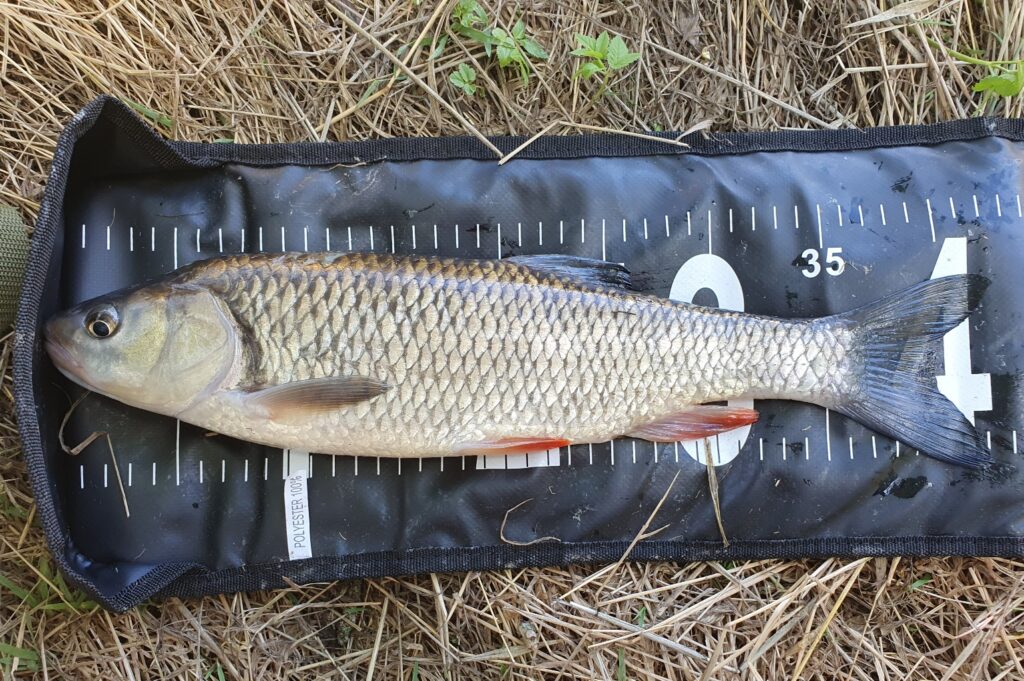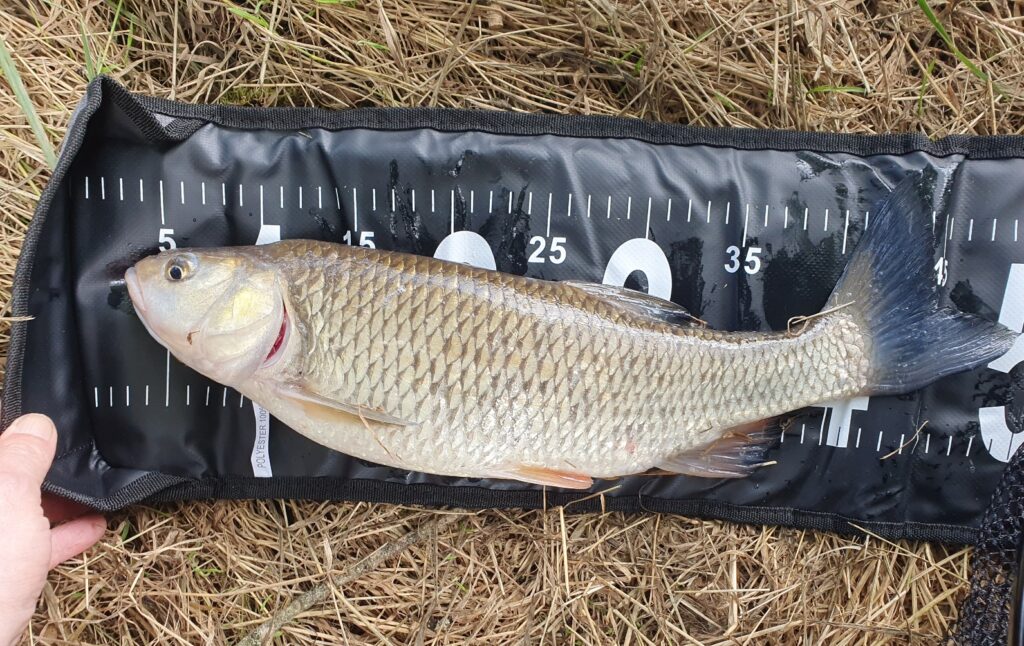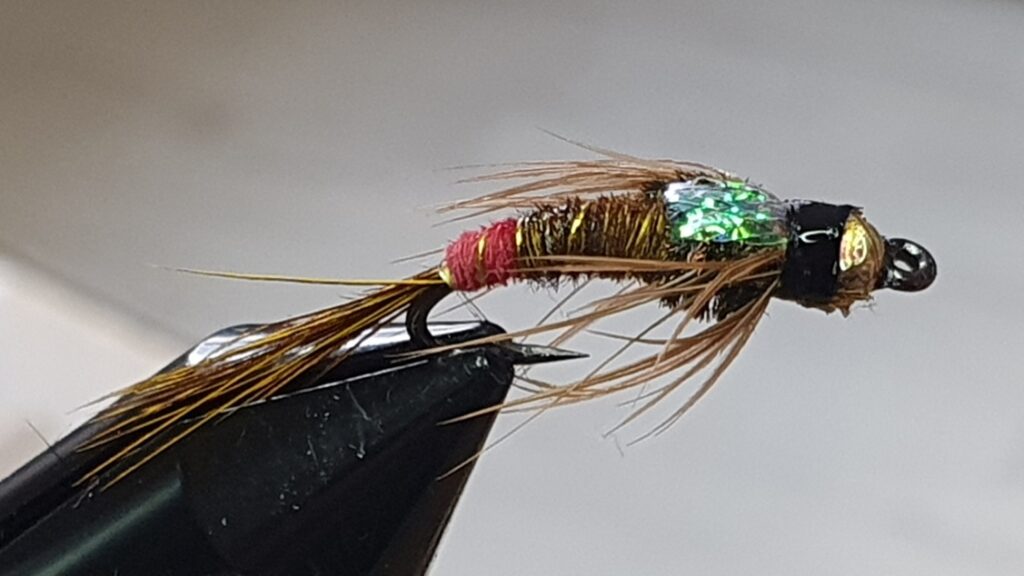
Small River Chub
Chub have long been my favourite species of fish to target, especially on small rivers and streams.
As a child, teenager and young adult I would often fish for Chub on various stretches of the river Colne, west of London. Usually on ledgered or float-fished cheddar cheese, freelined bread crust or, occasionally, using maggots.
Last year (2023) I caught a fair number of Chub on my favourite river here in West Bohemia, the Radbuza river using either ledgered sweetcorn, floating bread crust or jigs.

The Switch to Fly Fishing
For 2024 I decided to change my approach and to target the Radbuza Chub with flyfishing gear – a method I used some 25 or so years ago on the river Couesnon in Brittany, France.
For me this is the best way to fish as the tackle required is minimal and it allows the angler to immerse him- or herself in the surrounding nature and, while wading, to gain access to areas of river not available from the bank.

So this post is about my approach to fishing small rivers for Chub.
The tackle I use is very simple and minimalist – travelling light is a necessity for this kind of fishing and makes for a relaxed time spent in and on the river.
Rod and Reel
The rod I use is old, made sometime in the 1980s by House of Hardy. It’s an 8 foot, 4/5 weight Favourite F.T. Graphite model which has a fairly soft, through action when compared to modern rods and, while it’s rated for #4 or #5 lines, it performs best with a 4 weight line.

The reel is a somewhat more modern piece of tackle, just a few years old although, sadly discontinued, it’s a perfect match in size and weight for my Hardy rod. It’s a Negnon Sirius 3/4 weight reel loaded with a Hanák Competition Wave DT4F line.
Other Tackle
Other than the rod, reel and line, I wear a pair of waders and carry only a landing net which is strapped to my back and a small shoulder bag in which I keep my flies, leaders, tippet material and unhooking/measuring tools.
That’s all I need apart from a rimmed hat, a pair of polarising sunglasses, my phone and some insect repellent.
One more item I will, somewhat contraversially, sometimes carry in my bag is a couple of slices of bread. This is not to be used as a hook-bait but to help determine which species are present in the swim. Traditional flyfishers will probably frown at this approach, but I don’t care – this is my method.

Leaders & Tippets
As far as leaders are concerned, I keep things simple by making my own from two or three lengths of progressively thinner monofilament line with a loop at one end and a tippet ring at the other.
Tippet material depends on the fly, or flies, I am using. If I am using a dry fly I use a length of monofilament and for a wet fly or nymph, fluoro carbon.
When using the New Zealand method, often refered to as a dry-dropper, I will use a monofilament tippet to the dry fly and fluoro carbon between the dry fly and point fly.
As far as leader length is concerned, I keep them short by most people’s standards. Probably 7ft plus a foot or two of tippet – I don’t measure them precisely so it’s possible that they may sometimes be a bit longer or shorter. My rod is short at 8 feet and the river is small with mostly overgrown banks, so this seems to work fine.
The Most Important Item of Tackle
Finally, in my pocket I always carry a bottle of Fish First Aid which all anglers should have with them in case they come across an injured fish!
Flies for Chub

The flies I use are all self-tied and not particularly ‘traditional’ but often based on or inspired by traditional patterns. I’ve posted a lot of the patterns I use here and you can find them by looking at the Chub Flies page in the menu or by following this link: Chub Flies.

Disclaimer: I’m not an expert fly-tyer and have clumsy hands and weak eyes, so don’t expect them to be as spectacular as Barry Ord Clarke’s wonderful flies!
Barry Ord Clarke’s Website:

Chub Flyfishing Methods
The methods I use to fish these flies depends on water conditions and the features of each swim – upstream dry, downstream wet, across and down, drifting, etc. There are many sources of information about river flyfishing and, as I am by no means an expert, I’ll leave better anglers than myself to detail the various methods used – I wouldn’t want anybody to pick up my bad habbits.

I generally fish all the usual places – deeper pools often created by the remains of fallen trees, areas lined with covering foliage, creases, below weirs and undercut banks of which my favourite stretch has many, created by the Nutria / Coypu population. These are popular ambush points used by Chub, but also Pike, Zander and Catfish.
I’m not a fan of Euro Nymphing styles of fishing as, in the waters I fish, I don’t see any advantage – it seems to me that it would be just as effective to trot a float on a centre-pin outfit, and for that I don’t need to spend any money on new equipment.
Further Information
It’s difficult to advise on sources of further information as a lot depends on the waters being fished, this and conditions will dictate the use of various options.
Having said this, I feel that Dominic Garnett’s book ‘Flyfishing for Coarse Fish’ may be a good place to start as well as his YouTube videos on the subject.
A Final Comment
One last comment I would like to make is in relation to many people’s claims that Chub are spooked more easily than other species.
In my experience this is not the case – fishing of any kind and for any species involves an element of stealth. When wading or fishing in close proximity to a feeding fish or shoal, any dramatic action will cause the target, or his friends, to run.
It’s a mechanism of self protection and doesn’t apply to Chub any more than to Trout, Roach or any other fish.
When you hook a Chub (or any fish) they will fight and any other fish in the swim may sense the danger and get out of there as quickly as possible – no matter what their species.
Pike Will Spook Chub
Another cause of spooked fish that I see often is the presence of bigger predators – often Pike – who will lay low, but the Chub know they’re there.
A hooked fish often provokes a follow or an attack by the Pike and, any other Chub in the area, already aware of the threat, will quickly disperse.
The angler can do nothing to avoid this situation and it doesn’t suggest that Chub are easily spooked.
Chub Have Less Fear Than You Think, So Relax!
Sometimes Chub will just feed on what you are presenting to them with no apparent fear. Again, this is not limited to Chub.
A good example that helps to prove my point is a video published by Chris, the Ginger Fisherman on YouTube in which he catches a number of nice small river chub from a single swim, one after the other – these fish were certainly not spooked and he had a great session with some lovely Chub!
Please don’t be put off by these claims as in my experience they are just not true provided you use common sense. I wouldn’t recommend jumping about or dancing on the bank or in the river, obviously, but there is normally no need to crawl about commando style either.
Chub are no more difficult to catch than Trout. So go to your local small river and catch some Chub on the fly.
